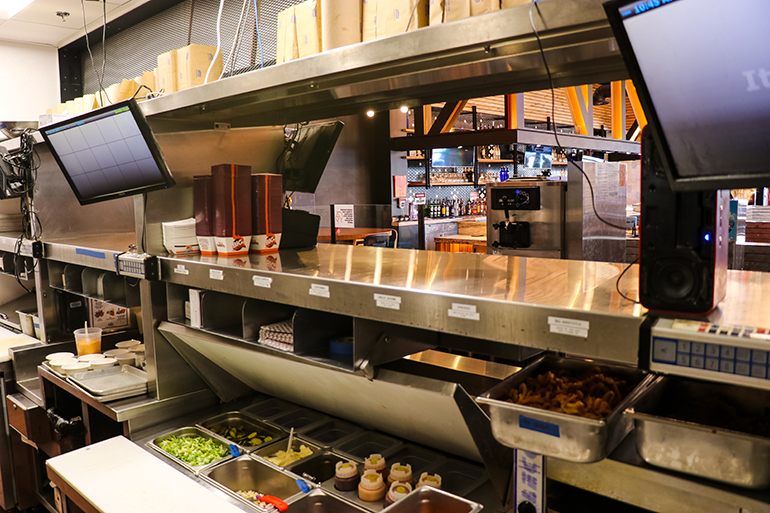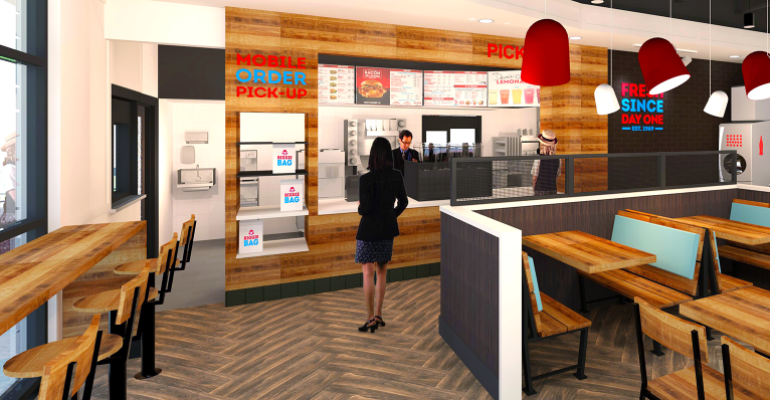Restaurant operators are incorporating versatility and efficiency into their kitchen designs, aided by the deployment of equipment that streamlines food assembly and throughput.
Equipment increasingly works hand-in-hand with digital ordering and kitchen display technologies to optimize labor, especially as digital ordering and off-premises dining have complicated operations.
Equipment efficiency was top of mind when Wendy’s designed its new Global Next Gen restaurant prototype, which features a double-sided grill, a galley kitchen layout and a modular design. These elements work together to not only streamline workflows and provide the flexibility for future innovation, but also create a better experience for workers, said Deepak Ajmani, U.S. chief operations officer for Wendy’s.
“We know increasing efficiency creates a more fun and energizing environment for crew members, and that ultimately leads to great customer experiences,” he said. “We adopted a ‘crew first’ mentality when designing Wendy’s new global restaurant standard, which meant constantly asking ourselves, ‘How can we remove friction points for the restaurant team?’”
The first location featuring the new design is scheduled to open later this year in New Albany, Ohio.
The new, galley-style kitchen, which runs from the front to the back of the restaurant, gives the crew line of sight across all ordering channels and allows them to slide between positions more easily throughout the day, said Ajmani. In addition, using a wheeled, modular equipment package will facilitate installation, make cleaning easier for the crew, and also provide the company with flexibility if menu innovations call for equipment changes.
“While the base design supports 95% of current restaurant volume ranges, the package is flexible to easily accommodate added horsepower like additional fryer vats or grill platens,” Ajmani said. “And because it’s off-the-shelf equipment, these pieces offer lower construction lead times and lower initial and maintenance costs.”
The design, he said, is also geared to accommodate digital orders, with the ability to handle 400 times the digital capacity of its current volume.
The Global Next Gen kitchen equipment, which also includes a prep label printer and a ware-washing machine, was selected with the goal of being able to deliver “more Wendy’s to more people with an emphasis on convenience, speed and accuracy,” said Ajmani.
“The new design also provides demonstrated labor optimization improvements, which add up to valuable savings,” he said, citing the positioning of the ordering and order-expediting areas as an example.
“That means front counter and pick-up window teams can slide between positions easily throughout the day,” he said. “From the use of technology and automation to the location of equipment, everything is designed to cut out unnecessary labor costs and reduce the number of steps or minutes that crew members need to deliver Wendy’s orders to our customers while creating better returns for our franchisees.”
Labor is the key concern
Chris Monico, VP at Indianapolis-based C&T Design and Equipment Co., said creating labor efficiencies has taken on increasing importance for the company’s restaurant clients.
“Pre-pandemic, it was important; post-pandemic, it’s a necessity,” he said. “Labor is probably the No. 1 issue for most operators. We try and do everything we can do to make sure that they can operate a kitchen successfully with the smallest amount of labor that they can.”
At the same time, many restaurants are also seeking to reduce their footprints, which adds a wrinkle to kitchen design. As a result, Monico said, C&T works with operators to group kitchen workstations more efficiently so that a single kitchen employee can oversee more than one workstation at a time, for example.
“We are seeing a lot of consolidation of workspaces in general,” he said. “There ends up being a lot more things for one person to do, in a smaller space.”
High-speed cooking equipment is becoming more prevalent in this environment, as well as multi-functional equipment such as combi ovens, including smaller, wall-mounted versions. Ventless cooking technology can also add efficiencies in kitchen design, Monico said.
“If I can create a dessert station, for example, and put a small combi oven above it, that person doesn’t have to go back and forth to the hot line,” he said.
Kitchens designed by chefs
At Big Chicken, the Shaquille O’Neal-backed chicken-sandwich chain focused on chef-driven recipes and high-quality ingredients, the kitchens are all designed by the chain’s culinary team to optimize efficiency, said Josh Halpern, CEO.
“They work with a kitchen designer hand-in-hand, but every kitchen that's approved from Big Chicken is approved by our chefs,” he said.
Big Chicken’s operating system revolves around having its spices, sauces and certain other ingredients made to spec and delivered, minimizing in-store prep labor. The equipment configuration further drives efficiency, Halpern said.
Among the equipment that helps optimize throughput at Big Chicken is a toaster with a butter wheel that automatically butters buns, high-recovery fryers that return to cooking temperatures quickly — a critical feature in the chain’s high-volume locations, which can process 800-900 sandwiches in a two-hour window — and a self-pasteurizing ice cream machine that requires less frequent cleaning.
Big Chicken generally has one person each designated for cooking fries and chicken, and others dedicated to the assembly of sandwiches and other dishes. It uses a breading table, where chicken is breaded to order using a breading recipe that has been prepared using Big Chicken’s recipe by a supplier.
The restaurants also have a flat-top grill for the minority of customers who order grilled chicken, and where the Crispy Chicken Grilled Cheese sandwiches are prepared.
Despite the compact size and layout of many Big Chicken locations, which include a handful of nontraditional venues, the company envisions its kitchens to be versatile and its equipment to be multi-functional, Halpern said.
“We asked ourselves, ‘How else can we be using this piece of equipment?’” he said. “That is core to who we are as a company, whether it’s equipment or ingredients. We’re always looking to see how we can repurpose our equipment and ingredients in different ways so that we can maximize production or maximize yield."

At Big Chicken, the kitchens are all designed by the culinary team.
Smashburger combines theater, efficiency
At Smashburger, the company combined the need to operate efficiently with the desire to incorporate some theatricality into its food preparation. The chain had been using clamshell-style grills to fry its signature smashed burgers, but over the past few years switched back to traditional one-sided flat-top grills, which allows customers to see the burgers getting smashed, said Carl Bachmann, president of the chain.
“We redesigned our kitchen so that the grills are front and center in our windows, so the guests can experience that,” he said, adding that the positioning of the grill also makes it easier for the cook to place the cooked burger onto the “set table,” where the toppings are applied before moving on the expediter.
Using the flat grill also gives the company greater control over the quality of the burger, Bachmann said, citing the specific process for creating a “sear” on the burger to lock in its juices.
In addition to the flat grills, Smashburger has also added several technology implementations to further aid efficiency and accommodate increasing demand for off-premises dining, including drive-thru and delivery orders. Technologies include a cubby system for order pickup, plus use of technology from Olo for digital order processing and from Curbit, which aids in the timing of order assembly to optimize the timing of the cooking of fries for off-premises orders, for example.
“It’s not so much the equipment as much as it is how we use the equipment,” said Bachmann.
Among other equipment the company is testing are different warming systems to help optimize product quality.
Between the cubby pickup system, the increase in digital ordering and other changes, the company has been able to operate more efficiently, Bachmann said.
“We've definitely improved our labor over the last couple of years in spite of wages going up much higher,” he said. “We've been able to improve our actual transactions per man hour with these efficiencies.”





